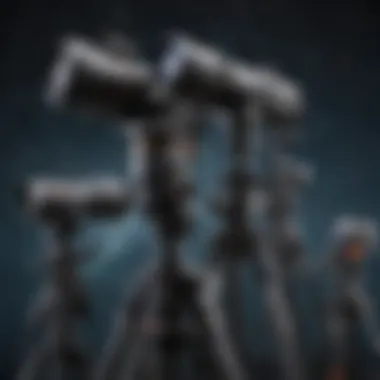Navigating the Cosmos: Best Telescopes for Galaxies


Intro
Understanding the intricacies of astronomy involves more than just curiosity about the night sky. It calls for a nuanced approach to selecting the right telescope for galaxy viewing. The world of telescopes is diverse, embodying various designs and functionalities that cater to distinct observational needs. This article aims to assist both novice and experienced astronomers in making informed choices to enhance their stargazing experiences.
Effective galaxy observation hinges on several critical factors, including aperture size, mount types, and the inclusion of auxiliary equipment. Each of these elements plays a crucial role in defining the telescope's capabilities and overall performance. For anyone passionate about exploring distant galaxies, being equipped with the right tools is vital.
Moreover, the selection process can be overwhelming given the plethora of options available today. Understanding the essential criteria will not only clarify preferences but will also bolster the observational experience. Let's navigate the cosmos together by diving deeper into key concepts surrounding effective telescopes for galaxy viewing.
Understanding the Importance of Telescopes in Astronomy
Telescopes represent a critical component in the field of astronomy, serving not merely as tools but as gateways to understanding the universe. These instruments allow both amateur and professional astronomers to explore celestial phenomenon far beyond the reach of the naked eye. By magnifying distant objects and gathering more light, telescopes unveil the secrets of galaxies, stars, and planets.
The Role of Telescopes
Telescopes play a vital role in expanding our comprehension of astronomy. Their main function is the collection and magnification of light from distant celestial bodies. This enables astronomers to analyze the structure, composition, and behavior of these objects. The advancements in telescope technology have led to discoveries that reshape our understanding of the cosmos. For instance, telescopes can reveal the presence of exoplanets, study their atmospheres, and even detect signals indicative of potential life.
Moreover, telescopes support a plethora of scientific activities, including:
- Observational Astronomy: Gathering data on celestial phenomena.
- Astrophysics: Analyzing the physical properties of astronomical objects.
- Astrobiology: Investigating the potential for life beyond Earth.
With each advancement, telescopes not only enhance our observation capabilities but also foster deeper inquiry into fundamental cosmic questions.
Historical Context
The history of telescopes is as fascinating as the objects they observe. The first practical telescopes emerged in the early 17th century, with Galileo Galilei utilizing them to study the moons of Jupiter and the phases of Venus. This revolutionized astronomy, laying the groundwork for future exploration. The refractor telescope, crafted from lenses, became the standard in the following centuries.
However, the reflectors, invented by Isaac Newton, offered significant improvements. They used mirrors to collect light, avoiding issues like chromatic aberration seen in refractors. This marked a pivotal moment, fostering a new era of astronomical study. Fast forward to the 20th century, the Hubble Space Telescope emerged, providing breathtaking images and data, further broadening our understanding of cosmic phenomena.
Each stage in the evolution of telescopes showcases human curiosity and innovation, exemplifying our relentless quest to understand the universe. As technology evolves, so too do our telescopes, promising even more remarkable insights into the cosmos.
Types of Telescopes for Galaxy Viewing
The selection of a telescope plays a crucial role in the endeavor of galaxy observation. Each type of telescope presents unique characteristics, advantages, and limitations that cater to different viewing preferences and situations. Understanding these distinctions can lead to more informed choices, maximizing the likelihood of a fulfilling stargazing experience.
Refractors
Refractor telescopes employ lenses to gather and focus light. Their design is fairly simple, consisting of a set of glass lenses placed in a tube. The primary advantage of refractors is their ability to produce clear and sharp images, making them ideal for viewing planets and bright galaxies. They require minimal maintenance and are usually robust.
However, refractor telescopes have limitations. The larger the aperture, the heavier and more costly they tend to be. Moreover, chromatic aberration can occur, leading to color fringing around bright objects. To mitigate this issue, higher quality refractors employ additional lens elements. Serious galaxy observers may find that while refractors excel at planetary viewing, they may not capture the faint details of distant galaxies as effectively as other types.
Reflectors
Reflector telescopes utilize mirrors to gather light. The design allows for larger apertures without the weight concerns associated with large refractors. This characteristic makes reflectors particularly advantageous for galaxy viewing. With a larger aperture, these telescopes can capture more light, revealing fainter celestial objects, including dim galaxies.
Reflectors often present challenges related to maintenance, as the mirrors require regular cleaning to retain optical clarity. They are also more susceptible to misalignment, which can affect image quality. Nonetheless, when properly operated, reflectors provide a compelling option for amateur astronomers who wish to delve deeper into the cosmos, especially those interested in studying galaxies and other fainter objects.
Catadioptrics
Catadioptric telescopes combine mirrors and lenses to harness the strengths of both refractors and reflectors. This hybrid design leads to improved portability and versatility, as these telescopes can provide high-quality optics in a compact form. They are particularly popular among amateur astronomers who appreciate both ease of use and performance.
The diversity in design allows catadioptrics to excel in various scenarios, including galaxy viewing. Their ability to gather light effectively means that they can reveal more intricate details of galaxies. However, they can be more complex to set up and operate compared to pure refractor or reflector designs.
In summary, the choice of telescope type plays a fundamental role in the pursuit of observing galaxies. Each type has its own merits and challenges. Knowing your preferences, the conditions of your viewing site, and your willingness to maintain equipment will guide the decision-making process.
Key Features of Telescopes for Galaxy Observation
When choosing a telescope for galaxy observation, understanding key features is essential. These features significantly affect the quality of views and the overall experience for both novice and experienced astronomers. Identifying the right parameters can make a difference between seeing hundreds of stars in a galaxy or just a few blurred images. This section delves into three crucial aspects: aperture size, optical quality, and field of view, each playing a specific role in enhancing galaxy viewing.
Aperture Size
Aperture size is perhaps the most critical feature of any telescope. It refers to the diameter of the primary lens or mirror. A larger aperture allows more light to enter the telescope, resulting in brighter and more detailed images. For galaxy observation, where objects are often faint, a larger aperture becomes particularly advantageous. Telescopes with an aperture of at least 4 inches (100 mm) are recommended for beginners aiming to see more than just the brightest galaxies.
The increased light-gathering power also improves the resolution of the images, allowing observers to pinpoint finer details such as spiral arms and core structures within galaxies. For example, a telescope with an 8-inch aperture can reveal more intricate structures in the Andromeda Galaxy compared to a smaller 4-inch model. However, larger apertures require more careful consideration to transport and set up due to their weight and size.
Optical Quality
Optical quality refers to how well the telescope can focus light to produce clear and sharp images. This characteristic encompasses various factors, including lens and mirror construction, coating, and the precision of elements in the optical system. High-quality optics are crucial for galaxy viewing because they ensure that the images produced are not overly distorted or lacking in detail.
The use of premium glass and multi-coatings can enhance light transmission. This, in turn, affects the brightness and contrast of the objects being observed. Higher optical quality minimizes chromatic aberrations – a common defect in lenses where colors do not focus at the same point, leading to blurriness. Renowned brands like Takahashi and Tele Vue are often recommended for their superior optical offerings. Investing in a telescope with quality optics is vital for serious stargazers committed to galaxy exploration.
Field of View


Field of view (FOV) indicates the width of the visible area through the telescope at a given distance. This feature is important for galaxy observation, especially when attempting to view larger galaxies or groups of galaxies. A wider field of view allows observers to capture more of the night sky in a single glance, which can enhance the experience of exploring extensive celestial features.
An appropriate eye piece can expand the field of view. For example, using a low-power eyepiece with a telescope can provide a broader overview of galaxies like the Virgo cluster, which contains multiple galaxies within a small portion of the sky. Conversely, medium to high-power eyepieces offer detailed views of individual galaxies. Balancing between these eyepiece choices is key, depending on whether the goal is a broader visual context or a closer examination.
"In astronomy, your choice of telescope directly influences your ability to explore and appreciate the cosmos."
"In astronomy, your choice of telescope directly influences your ability to explore and appreciate the cosmos."
Understanding these features of telescopes is crucial for anyone wishing to take their galaxy observation to the next level. By considering aperture size, optical quality, and field of view, astronomers can optimize their tools for a more rewarding stargazing experience.
Mount Types for Telescopes
Choosing the right mount type for your telescope is essential for effective observation of galaxies and other celestial objects. The mount acts as the foundation for your telescope, allowing for precise positioning and ease of movement. It not only supports the telescope but also affects the overall viewing experience, including stability, tracking, and setup complexity. Understanding the different mechanisms of telescope mounts will enhance your observation sessions and make them more enjoyable.
Altazimuth Mounts
Altazimuth mounts provide a simple, user-friendly design. They move in two directions: up and down (altitude) and side to side (azimuth). This makes them intuitive for those new to astronomy. Setting up an altazimuth mount is typically straightforward. An observer can aim at a target by simply moving the telescope in horizontal and vertical planes. The benefit is a natural feel that mirrors how we observe objects in our environment.
However, there are some considerations to bear in mind. This mount is best for observing objects that do not move across the sky at an angle, like stars. When tracking celestial objects that move with the Earth's rotation, adjustments need to be made frequently. This can be cumbersome during extended observations.
Advantages of Altazimuth Mounts:
- Easy to use for beginners
- Quick setup and movement
- Compact design suitable for portability
Disadvantages of Altazimuth Mounts:
- Requires frequent adjustments for tracking
- Less stable at high magnifications, leading to shaky views
Equatorial Mounts
Equatorial mounts are a preferred choice for serious astronomers. Unlike altazimuth mounts, equatorial mounts align with the Earth's axis. This allows for smooth tracking of celestial objects as they move across the sky. Observers can simply set the mount to the correct latitude and polar align it. Once set, tracking an object becomes much easier. Only one adjustment is needed to keep the telescope on the target.
This design supports high magnification, making it ideal for detailed galaxy observations. Equatorial mounts also often come with advanced features like motorized tracking, which can automate the process. However, setup can be more complicated compared to altazimuth designs. Some users might find this a barrier to entry.
Advantages of Equatorial Mounts:
- Excellent for tracking celestial objects over time
- Supports high magnification without excessive movement
- Compatibility with motor drives for automation
Disadvantages of Equatorial Mounts:
- More complex setup and initial alignment
- Typically heavier and less portable than altazimuth designs
"Choosing the right mount is crucial for an effective observing session. Each mount type offers distinct advantages that cater to different astronomy needs."
"Choosing the right mount is crucial for an effective observing session. Each mount type offers distinct advantages that cater to different astronomy needs."
Understanding these two primary mount types will enhance your ability to enjoy galaxy viewing. Make an informed decision based on your specific requirements and level of experience. Consider the type of objects you wish to observe and your comfort level with telescope setup and operation.
Additional Equipment for Enhanced Viewing
When it comes to galaxy observation, additional equipment can significantly enhance the experience. While having a quality telescope is fundamental, supplementary tools can refine viewing capabilities and open new avenues for exploration. Understanding these components is essential for anyone serious about their astronomical endeavors. This section details two key types of additional equipment: binoculars and filters, and Barlow lenses.
Binos and Filters
Binoculars serve a distinct role in the realm of astronomical observation. They provide a wider field of view than most telescopes, making it easier for amateur astronomers to locate celestial objects. With binoculars, one can quickly scan the night sky for galaxies like Andromeda or the Whirlpool Galaxy.
Filters offer an important advantage, especially when observing specific wavelengths of light emitted by celestial bodies. They can enhance contrast and clarity, making certain galaxies more visible by filtering out excessive light pollution. For instance, a light pollution filter can improve visibility in urban areas by blocking out artificial light, allowing fainter celestial objects to emerge clearer against the dark sky.
Benefits of Using Binoculars and Filters:
- Ease of Use: Binoculars are generally user-friendly, requiring less setup.
- Enhanced Contrast: Filters improve the visibility of details within galaxies, showing more structure.
- Portability: Many binoculars are lightweight and easy to carry, ideal for impromptu stargazing sessions.
Barlow Lenses
Barlow lenses are another essential addition to the astronomical toolkit, particularly valuable for enhancing magnification. By inserting a Barlow lens between the telescope's eyepiece and the optical tube, you can effectively double or triple the power of the eyepiece. This enhancement allows for a closer examination of distant galaxies, making intricate details more discernible.
However, it is crucial to choose a high-quality Barlow lens, as a poor one may introduce aberrations or distortions. A well-constructed lens will maintain image clarity while expanding magnification options. This makes Barlow lenses a cost-effective alternative to purchasing multiple eyepieces.
In summary, additional equipment like binoculars, filters, and Barlow lenses play a vital role in successful galaxy observation. They not only enhance the viewing experience but also allow astronomers to engage deeply with the cosmos and observe phenomena that may otherwise remain hidden.
Choosing the Right Telescope for Your Needs


Selecting the right telescope is not just a matter of preference; it is a vital step for anyone wishing to explore the vastness of the galaxy. A well-chosen telescope can significantly enhance the stargazing experience, enabling clearer views of celestial bodies, including galaxies. This section will discuss key factors that play a role in making this crucial decision.
Identifying Viewing Preferences
Before diving into specific models or brands, it is essential to identify your viewing preferences. Different telescopes cater to different observing goals. Some common considerations may include:
- Type of Objects: Are you more interested in viewing galaxies, or do stars and planets capture your attention?
- Level of Detail: Understand how much detail you wish to see. Higher magnification may be necessary for certain galaxies, while others may be more suited to wider fields of view.
- Frequency of Use: Will you use the telescope for casual observing or more serious astronomical study?
For instance, if you are inclined toward deep-sky observations, a telescope with a larger aperture may be a better choice. Meanwhile, compact telescopes can be ideal for those who need portability and ease of setup. Taking these preferences into account will guide you in selecting a telescope that aligns with your personal astronomy ambitions.
Budget Considerations
Budgeting plays a crucial role in telescope selection. Telescopes can vary tremendously in price, ranging from several hundred to thousands of dollars. Consider the following points when planning your budget:
- Initial Investment: Determine how much you are willing to spend on the telescope itself.
- Accessories: Factor in the cost of necessary accessories such as eyepieces, filters, or mounting equipment.
- Long-Term Costs: Telescope maintenance and possible upgrades can lead to additional expenses. It is wise to plan for the future, as you may want to expand your setup over time.
Cost-effective options may still provide excellent viewing experiences, especially for beginners. Investing in a reliable telescope can be more beneficial than purchasing a high-end model that far exceeds your actual needs. Establishing a budget can streamline your search and help you focus on telescopes that fit within your financial parameters, allowing for smarter choices.
"Choosing wisely not only enhances enjoyment but also ensures that financial investment yields the best possible experience in astronomy."
"Choosing wisely not only enhances enjoyment but also ensures that financial investment yields the best possible experience in astronomy."
Consider exploring forums like Reddit or academic articles for additional insights into finding the right fit for both your needs and your budget.
Understanding your preferences and financial confines lays the groundwork for a satisfactory telescope selection. This strategic approach not only optimizes personal enjoyment but also cultivates a deeper appreciation for the cosmic wonders awaiting exploration.
Best Practices for Galaxy Viewing
Observing galaxies through a telescope can be one of the most rewarding experiences in astronomy. However, achieving optimal views requires more than just having the right equipment. This section focuses on best practices that enhance galaxy viewing, touching on site selection and timing, both critical for gaining the best visibility of these celestial structures. Following these guidelines will not only improve the quality of your observations but also make the experience more enjoyable.
Location Selection
Choosing the right location is fundamental for effective galaxy viewing. Light pollution from urban areas significantly affects visibility. To mitigate this, consider the following:
- Dark Skies: Seek locations far from city lights. Dark Sky Parks or rural areas are ideal.
- Altitude: Higher altitudes reduce atmospheric interference, providing clearer views of the night sky. Look for mountainous regions or elevated plateaus.
- Weather Conditions: Check the forecast for clear nights with low humidity. Cloud cover can obstruct your view, while high humidity can distort it.
- Stable Atmosphere: Observing from locations with minimal wind and atmospheric turbulence enhances detail in the objects being observed.
By carefully choosing your location, you can enhance your ability to observe galaxies clearly and collect data for your astronomical notes.
Timing Your Observation
Timing is another crucial factor that can dramatically impact your experience when viewing galaxies. Consider these elements:
- New Moon: Plan your observations during the new moon phase. The lack of moonlight minimizes glare and allows for the faint light of distant galaxies to become more prominent.
- Galaxy Positioning: Familiarize yourself with the positions of galaxies throughout the year. Some galaxies are more visible at certain times, so using star charts or astronomy apps for planning is helpful.
- Seasonal Considerations: Specific seasons may offer clearer skies for galaxy visibility. For example, winter months often have stable conditions and lower humidity in many regions.
By synchronizing your observations with these factors, you can significantly increase the likelihood of successful galaxy viewing sessions.
"Observing based on thoughtful timing and location choices can enhance the astronomical experience greatly, from clarity of view to overall enjoyment."
"Observing based on thoughtful timing and location choices can enhance the astronomical experience greatly, from clarity of view to overall enjoyment."
Taking these practices to heart allows for a more fruitful and fulfilling exploration of the cosmos, as each observation becomes a chance to connect more deeply with the universe.
Common Challenges Faced
When engaging in galaxy viewing, astronomers, both amateur and seasoned, face a range of challenges that can obstruct the clarity and quality of their observations. Understanding these challenges is vital for a fruitful astronomical experience. The following sections address two prominent obstacles: light pollution and weather conditions. Both elements significantly impact visibility and the overall enjoyment of observing distant galaxies.
Light Pollution
Light pollution is perhaps the most pervasive challenge encountered by those seeking to observe galaxies. Urban areas, inundated with artificial lighting, present a formidable barrier to spotting faint celestial bodies. This general brightness washes out the subtler details of the night sky, making it difficult to discern stars and, in turn, galaxies that may be located behind them.
To combat this issue, astronomers often seek darker sites for viewing. Areas situated away from the urban sprawl, such as national parks or remote locations, provide a more favorable environment. Many astronomers also invest in specialized filters designed to reduce the effects of light pollution. These filters work by selectively blocking certain wavelengths, helping to enhance contrast and reveal the celestial wonders hidden in brightness.
Moreover, researchers have noted the psychological component to light pollution. The overwhelming brightness can lead to a sense of frustration among stargazers. Thus, selecting an optimal viewing site not only deals with the physical limitations posed by light pollution but also caters to the emotional satisfaction that comes with a successful observation session.
Weather Conditions
Weather conditions significantly influence the outcomes of galaxy observations. The atmospheric state affects not only visibility but also the quality of images captured through telescopes. Humidity, cloud cover, and atmospheric turbulence can each obscure the view of celestial objects and distort light.
On nights with clear skies, the conditions can still vary drastically due to temperature fluctuations. For instance, larger telescopes may experience issues from thermal currents, which can distort images of distant galaxies. Consequently, knowing the local weather patterns and timing viewing sessions well is crucial for astronomers. Keeping tabs on forecasts and even historical weather trends can enhance the likelihood of providing an optimal viewing experience.
Additionally, everyone learns that patience is vital in astronomy. Day-to-day weather is unpredictable, and sometimes, clear nights can turn into cloudy ones unexpectedly. Therefore, it is advisable to have alternative plans in mind. Joining local astronomy clubs or online forums can help astronomers exchange information about good observing nights, further improving the chances of successful galaxy viewing.
"Understanding and adapting to common challenges in astronomy enriches the overall experience, leading to profound realizations beyond the mere observation of distant galaxies."


"Understanding and adapting to common challenges in astronomy enriches the overall experience, leading to profound realizations beyond the mere observation of distant galaxies."
In summary, both light pollution and weather conditions are key challenges in galaxy viewing. Recognizing these obstacles and planning accordingly can greatly enhance the viewing experience. Taking proactive steps increases the likelihood of observing the myriad of galaxies scattered throughout our universe.
Future Innovations in Telescope Technology
The field of astronomy is constantly evolving. As technology advances, so do the tools we use to explore the universe. Future innovations in telescope technology promise to significantly enhance our ability to view galaxies and other celestial bodies. This section will discuss some of the key advancements that can reshape our astronomical capabilities.
Advancements in Optics
Optics plays a crucial role in how telescopes function. The future of optical technology in telescopes is promising with developments such as adaptive optics. This technology corrects distortions caused by Earth's atmosphere in real-time. As a result, images of distant galaxies can be clearer and more detailed than ever before.
Furthermore, new materials like meta-materials and photonic crystals are being researched. These materials could offer improved light manipulation, leading to higher resolution images. Enhanced optical coatings will also allow for greater light transmission and reduced glare, a significant benefit when observing faint objects in the night sky.
In addition to material advancements, computational methods for image processing are advancing too. These processes help astronomers derive more information from the light received by telescopes, making even the faintest galaxies easier to study.
Digital Integration
The marriage between telescopic technology and digital tools is growing stronger. Digital integration refers to the use of software and digital interfaces to enhance observational efficiency and data analysis. Current advancements include automated tracking systems, where telescopes can follow celestial objects across the sky without manual intervention. This is particularly useful for time-sensitive observations.
Moreover, the integration of artificial intelligence in data analysis opens new doors. AI can sift through enormous data sets faster than a human can. It can identify patterns in celestial movements and recognize objects within vast data streams. This allows astronomers to focus on interpreting results rather than spending time on data processing.
Connected devices, such as smart devices and mobile applications, are also enhancing the user experience. Users can control their telescopes remotely, receive updates about celestial events, or even share observations instantly through social media. This connectivity can inspire a new generation of stargazers eager to explore the cosmos.
Case Studies of Notable Telescopes
Case studies of notable telescopes provide essential insight into the practical applications of astronomy. Analyzing specific telescopes offers a lens through which we can evaluate technology, achievements, and challenges in cosmology. Each telescope showcases unique features that reveal the importance of design and functionality in observing galaxies. This analysis not only highlights historic accomplishments but also sets the stage for future innovations in telescope technology.
Hubble Space Telescope
The Hubble Space Telescope, launched in 1990, represents a paradigm shift in our understanding of the universe. Operated by NASA and the European Space Agency, Hubble orbits the Earth allowing it to avoid atmospheric disturbances. This positioning helps achieve high-resolution imaging, which is crucial for discerning details in distant galaxies.
Hubble's primary mirror measures 2.4 meters in diameter, enabling astronomers to capture visible and ultraviolet light. Its instrumentation includes various cameras and spectrographs that facilitate a wide range of scientific investigations. Notably, Hubble has made significant contributions to cosmology, such as measuring the rate of expansion of the universe and discovering distant exoplanets.
Key benefits of Hubble:
- High sensitivity and resolution: Hubble has revealed finer details in galaxy structures.
- Long-term data collection: Ongoing observations contribute to our understanding of celestial phenomena.
- Public engagement: Iconic images from Hubble have captivated the public, fostering interest in astronomy.
Hubble's legacy is not without its challenges. The initial launch had technical problems, such as issues with the mirror's shape. However, servicing missions allowed engineers to rectify these problems, demonstrating the importance of maintenance for ground-breaking scientific instruments.
James Webb Space Telescope
The James Webb Space Telescope is another groundbreaking project that reflects advancements in astronomical research. Scheduled for launch in December 2021, Webb is designed to follow up on discoveries made by Hubble. With a larger primary mirror measuring 6.5 meters, Webb can collect more light, enhancing its ability to observe distant galaxies.
Webb's design focuses on infrared observations, allowing it to peer through cosmic dust and analyze phenomena that are invisible in the optical spectrum. This capability is set to advance our understanding of the universe, from the formation of stars to the study of distant galaxies.
Some notable features of Webb include:
- Segmented mirror design: This allows the telescope to operate efficiently while being transportable.
- Heat shield: A large, multi-layer sunshield protects Webb from solar radiation, maintaining low temperatures critical for infrared observations.
Webb aims to uncover historical aspects of our cosmos, such as detecting the earliest galaxies formed after the Big Bang. As it takes its position at the second Lagrange point, approximately 1.5 million kilometers from Earth, the implications of its findings are anticipated to be profound.
Both Hubble and Webb signify the evolution of telescope technology. Their case studies illustrate that through persistence and innovation, the field of astronomy continues to expand our comprehension of the universe.
The End
In the realm of astronomy, understanding the nuances of telescope technology is paramount. This article has highlighted the significance of selecting an appropriate telescope for galaxy viewing. Each element discussed—from different telescope types to essential features and challenges faced—is crucial for enhancing the stargazing experience.
A properly chosen telescope can dramatically affect the clarity and detail of celestial observations. Key factors such as aperture size and optical quality ensure the capacity to capture distant galaxies' beauty. Additionally, the choice of mounts plays a vital role in stability and ease of movement during observations.
"A telescope without proper support and equipment is like a book lacking pages; the experience will always be incomplete."
"A telescope without proper support and equipment is like a book lacking pages; the experience will always be incomplete."
Furthermore, amateur astronomers must consider additional gear, such as filters and Barlow lenses, to optimize their viewing potential. The case studies of notable telescopes further emphasize advancements in technology and their contributions to our understanding of the cosmos.
Summarizing Key Points
- Importance of Telescopes: They are indispensable tools that transform the invisible into the visible.
- Types of Telescopes: Each type—refractor, reflector, catadioptric—has unique advantages suitable for galaxy observation.
- Key Features to Consider:
- Additional Equipment: Useful accessories can enhance visibility and detail.
- Challenges: Awareness of light pollution and weather conditions ensures more fruitful observations.
- Future Innovations: Ongoing advancements promise even greater capabilities in observing distant galaxies.
- Aperture Size: Larger sizes allow more light, revealing faint galaxies.
- Optical Quality: Determines clarity and sharpness of images.
- Mount Types: Influence stability and tracking capabilities.
Encouragement for Exploration
Exploring the cosmos through a telescope is an intellectual and emotional journey. It encourages curiosity and fosters a deeper understanding of our universe. As you embark on this pursuit, take the time to experiment with different equipment and settings. Observing the majesty of galaxies firsthand can be profoundly rewarding.
Engage with communities online, such as those found on platforms like Reddit and Facebook, where shared tips and experiences can enhance your observational skills. Embrace the challenges and joys of astronomy, as each viewing can lead to new insights and amazement at the vastness of the universe.







